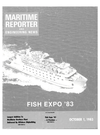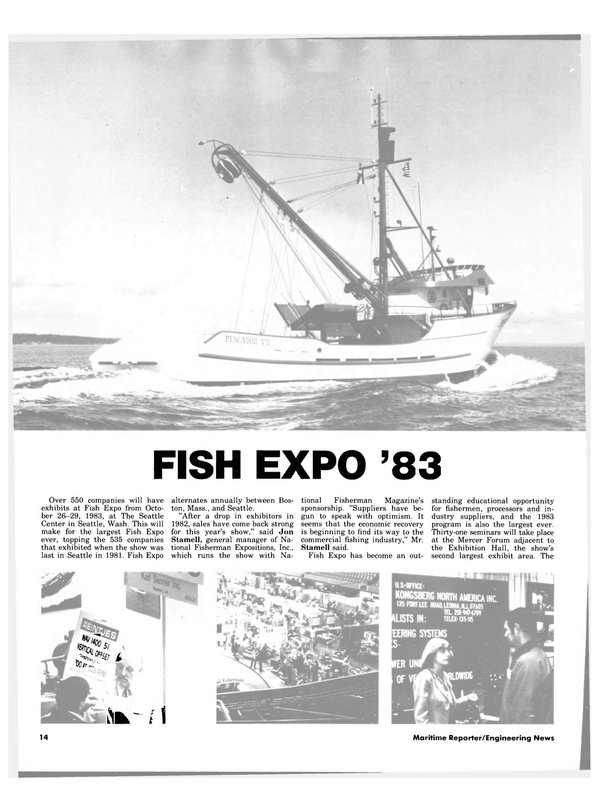
Construction Of Two RAN Minehunters Progressing At Carrington Slipways
Earlier this year, after intensive design investigation and development, the Commonwealth of Australia Department of Defense placed a contract with Carrington Slipways Pty Ltd. for the construction of two prototype catamaran minehunters for the Royal Australian Navy. Each is 31 meters in length, 9 meters abeam, displaces 170 tons and has a speed of approximately 10 knots.
The catamaran design for a minehunter allows a unique combination of proven concepts to be used which include: (1) A catamaran hull form which provides a large stable working area, reduces pressure signature and allows machinery to be placed high in the ship to reduce magnetic and acoustic signatures, minimizing the risk of mine activation. (2) Foam sandwich construction which further reduces the noise signature, provides good thermal insulation, requires a minimum of maintenance and provides improved shock resistance. (3) Use of twin diesel engines of a single type, each simultaneously driving a generator for ship power and a hydraulic pump for transmission of power to the propulsion steering units, all mounted well above the water line. (4) A containerized weapons control system which utilizes the functions of the navigational sensors, the sonar and the precision navigation equipment to control a recoverable submersible mine disposal vehicle.
The vessels are being built in a special purpose facility. The storage areas for GRP materials and the construction areas are environmentally controlled within strict limits to provide optimum conditions for applications and curing.
The hull core is made up of high density PVC foam which is glued together on a male mold. The outer skin is then laminated and the shell turned and put into a cradle for lamination of the inner skin and installation of internal bulkheads, decks and other substructure.
The main deck core is laid up on a concave mold and the concave side of the foam laminated.
The mold with the deck attached is then lifted, inverted, placed in position over the hull structure and secured. The deck mold is then removed and the upper side of the deck laminated and overlaid to the sides. The whole hull is then rotated through 180° to allow the lamination of the underside of both No. 1 and No. 2 decks. On completion of this operation the hull is turned again to the upright position.
The superstructure is assembled separately in the component area and installed as a unit following construction of the hull and upper deck.
GRP and foam sandwich components for construction and outfitting are manufactured in the component fabrication area. The hull is constructed in a 4-meter-deep construction dock which is fitted with lifting platform and turning mechanism to ensure that the hull can be lifted and rotated as necessary to achieve the best attitude for laminating activities.
A comprehensive quality program to the standard of AS1822 is utilized to ensure that the strict requirements for structural strength reproducibility and magnetic cleanliness are met.
The weapons containers, designed as part of the weapon system by Krupp Atlas Electronik, are also manufactured from foam sandwich in the facility using the same standards as are applied to the Minehunter.
Read Construction Of Two RAN Minehunters Progressing At Carrington Slipways in Pdf, Flash or Html5 edition of October 1983 Maritime Reporter
Other stories from October 1983 issue
Content
- Jeffboat Building Three Title XI Approved Cruise Vessels Worth $28-Million page: 4
- Tacoma Boat Completes $143-Million Financing To Build Two Thai Corvettes page: 5
- Blue Star Line To Add Four New Reefer Ships page: 5
- Centrico Forms New Mineral Oil Group Headed By Lohmeyer page: 5
- Joint Venture Receives Title XI For $109-Million Chemical Carrier page: 6
- COMSAT World Systems Division Announces Three Vice Presidential Changes page: 7
- National Steel Receives $13-Million Order To Overhaul The U.S.S. Cayuga page: 7
- Title XI Approved On $24-Million Package For Puget Sound Tug & Barge page: 8
- Lamberts Point Barge Title XI Approved For $20-Million Coal Barge page: 8
- E U R O P O R T ' 83 page: 8
- MARCO Pacific Shipbuilding Formed In Taiwan page: 9
- St. Louis Ship Delivers 6,000-HP Towing/Supply Boat To Gulf Fleet Marine page: 10
- Construction Of Two RAN Minehunters Progressing At Carrington Slipways page: 12
- FISH EXPO '33 page: 14
- Marine Coating Directory Is Offered By Farboil page: 19
- Radm. Meyer Receives New Assignment page: 20
- B&W Diesel Acquired By American M.A.N. page: 21
- Emergency Medical Course Offered By Marine Safety page: 21
- National Marine Opens New Facility In Norfolk page: 22
- $19.9-Million Contract Awarded Tracor By Navy page: 22
- Icebreaking Supply Vessel M/V Miscaroo Delivered By Vancouver Shipyards page: 22
- Apelco Relocates To Tampa, Names Vourloumis New Marketing Manager page: 23
- Hydranautics Shiplift Commissioned At Hyundai page: 23
- Terry To Manufacture And Sell AEG-Kanis Steam Turbines In North America —Literature Available page: 24
- High-Speed Supermaran Ferry Marine Hawk Enters Service page: 24
- M/V GRAND REPUBLIC page: 26
- NATO FRIGATES Current Situation And Future Design Trends page: 26
- Harris Awarded $12-Million WATERCOM Telephone Contract page: 32
- Environmental Systems Changes Name To Electrolux Envirovac page: 32
- Soviet Merchant Fleet Now 'Blankets The Globe' page: 33
- Drilling Rig Dry Transport Cuts 11,000-Mile Sailing Time In Half page: 34
- Notional Supply Advances Ayers To Product Manager page: 34
- Wijsmuller's First 'Mighty Servant' Heavy-Lift Carrier Is Commissioned page: 36
- Nichols Brothers Launches M/V Tiny page: 36
- CDI Marine Announces Management Reorganization page: 38
- Daewoo Delivers $74-Million Offshore Rig page: 39
- Change In Personnel Licensing Regulations For Commercial Ships Sought By U.S. Coast Guard page: 40
- Moss Point Marine Delivers 'Nicor Power' To Nicor Marine page: 40
- Marathon Oilfield Service Offers Color Brochure On Rigs And Resources page: 41
- Bath Iron Appoints Four New Directors page: 41
- Hitachi Announces Top Management Appointments page: 42
- Burrard Yarrows Delivers Icebreaker/Utility Vessels To Gulf Canada Resources page: 42
- NKK To Build Mobile Drilling Island For Beaufort Sea Project page: 42
- Peterson Builders Offers 56-page Review Of 50 Years Of Boatbuilding History page: 43
- Tenneco In Joint Venture To Operate Its Own Service Boats In Gulf page: 43
- McDermott Derrick Barge 27 Upgraded to 2,400-Ton Lift page: 47
- USCG Gentian Recommissioned After $8.3-Million Renovation page: 47
- Navidyne And Medical Advisory Systems Provide Free Introductory Medical Service page: 47
- Twin City Shipyard Delivers Split Hull Barges To Panama page: 49
- Wartsila AB Delivers LPG/Ammonia Tanker To Maraven In Venezuela page: 49
- Daewoo Employs Unique Floating Drydock And Ship Transfer System page: 49
- Blount Marine Delivers Star of Chicago To Star Line Corporation page: 53
- 380-Foot Drillship To Be Auctioned In Singapore page: 54
- General Dynamics Building Cargo Transfer Platform Barge With National Jacking System page: 54
- Nashville Bridge Delivers Pair of Utility Barges To Piling-Structures Inc. page: 58


